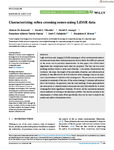Characterizing zebra crossing zones using LiDAR data

Use este enlace para citar
http://hdl.handle.net/2183/36272
A non ser que se indique outra cousa, a licenza do ítem descríbese como Atribución-NoComercial-SinDerivadas 3.0 España
Coleccións
- Investigación (ETSECCP) [827]
Metadatos
Mostrar o rexistro completo do ítemTítulo
Characterizing zebra crossing zones using LiDAR dataAutor(es)
Data
2023Cita bibliográfica
Esmorís, A. M., Vilariño, D. L., Arango, D. F., Varela‐García, F. A., Cabaleiro, J. C., Rivera, F. F. (2023). Characterizing zebra crossing zones using LiDAR data. Computer‐Aided Civil and Infrastructure Engineering, 38(13), 1767-1788. https://doi.org/10.1111/mice.12968
Resumo
[Abstract:] Light detection and ranging (LiDAR) scanning in urban environments leads to accurate and dense three-dimensional point clouds where the different elements in the scene can be precisely characterized. In this paper, two LiDAR-based algorithms that complement each other are proposed. The first one is a novel profiling method robust to noise and obstacles. It accurately characterizes the curvature, the slope, the height of the sidewalks, obstacles, and defects such as potholes. It was effective for 48 of 49 detected zebra crossings, even in the presence of pedestrians or vehicles in the crossing zone. The second one is a detailed quantitative summary of the state of the zebra crossing. It contains information about the location, the geometry, and the road marking. Coarse grain statistics are more prone to obstacle-related errors and are only fully reliable for 18 zebra crossings free from significant obstacles. However, all the anomalous statistics can be analyzed by looking at the associated profiles. The results can help in the maintenance of urban roads. More specifically, they can be used to improve the quality and safety of pedestrian routes.
Palabras chave
Light detection and ranging
LiDAR
Zebra crossings
Urban roads
Quality pedestrian routes
Safe pedestrian routes
LiDAR
Zebra crossings
Urban roads
Quality pedestrian routes
Safe pedestrian routes
Versión do editor
Dereitos
Atribución-NoComercial-SinDerivadas 3.0 España






